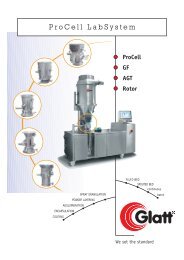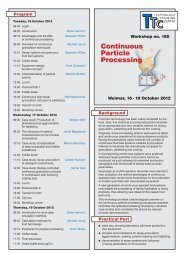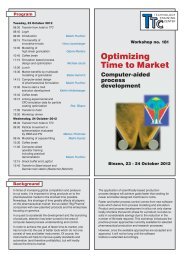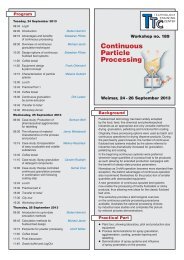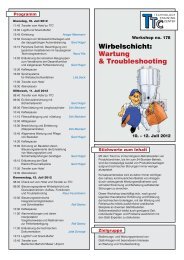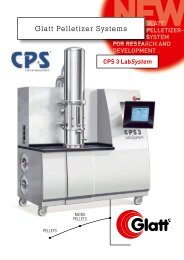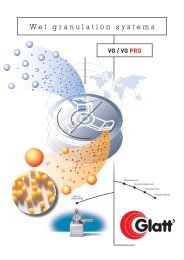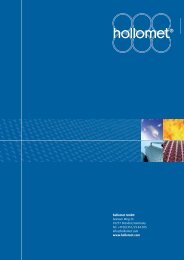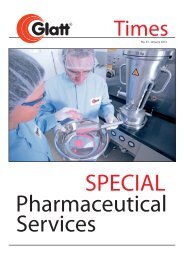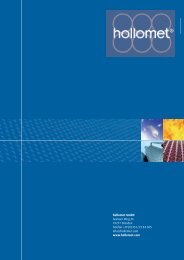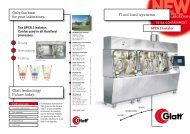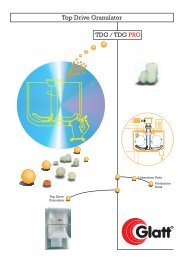You also want an ePaper? Increase the reach of your titles
YUMPU automatically turns print PDFs into web optimized ePapers that Google loves.
hollomet, Innovations <strong>in</strong> Cellular Materials<br />
<strong>Glatt</strong>, cellular materials and the hollomet GmbH<br />
The idea of manufactur<strong>in</strong>g cellular materials orig<strong>in</strong>ated through a<br />
close collaboration between the <strong>Glatt</strong> Systemtechnik GmbH and<br />
a neighbour<strong>in</strong>g research <strong>in</strong>stitute (IFAM, Fraunhofer Institute for<br />
Manufactur<strong>in</strong>g Technology and Applied Materials Research). The<br />
most important step <strong>in</strong> produc<strong>in</strong>g cellular materials is the<br />
coat<strong>in</strong>g, which is a core competence of the <strong>Glatt</strong> Group. After<br />
develop<strong>in</strong>g this material class for more than eight years as a department<br />
with<strong>in</strong> the <strong>Glatt</strong> Systemtechnik GmbH we decided to<br />
concentrate these activities <strong>in</strong> a new company called hollomet<br />
GmbH launched on January 1st 2009. In this timeframe many<br />
<strong>in</strong>terest<strong>in</strong>g applications have manifested from the countless possibilities,<br />
which we together with our customers want to turn <strong>in</strong>to<br />
<strong>in</strong>dustrial products.<br />
Due to be<strong>in</strong>g <strong>in</strong> quite similar bus<strong>in</strong>ess to IPC Dresden, with the<br />
ma<strong>in</strong> difference be<strong>in</strong>g our focus on metallic and ceramic materials<br />
we are its daughter company and part of the <strong>Glatt</strong>-group.<br />
Applications of cellular materials<br />
Here we would like to describe a few types of applications from<br />
the different fields of <strong>in</strong>dustry.<br />
- Mufflers small combustion eng<strong>in</strong>es<br />
For this application the <strong>in</strong>ner parts of the muffler are equipped<br />
with globomet ® structures (material: FeCrAl). The ma<strong>in</strong> advantages<br />
compared to conventional mufflers are the much simpler<br />
setup and the mechanical strength and corrosion resistance of<br />
this material at temperatures of up to 1.000 °C. Additionally measurements<br />
have shown an improved sound absorption and a higher<br />
power output / lower fuel consumption (due to a lower<br />
backpressure of the component) compared to a conventional<br />
component.<br />
- Adsorbents for oxygen production<br />
Coated carriers are ceramic spheres consist<strong>in</strong>g of an <strong>in</strong>ert carrier<br />
<strong>in</strong>side and a functional coat<strong>in</strong>g on the surface. This functional<br />
coat<strong>in</strong>g works as a catalyst (for chemical processes) or as an adsorbent<br />
(for separations). The overall efficiency of these processes<br />
is determ<strong>in</strong>ed by the velocity of the process (how fast is the<br />
process go<strong>in</strong>g on) and the capacity (amount of conversion per<br />
unit volume). Whereas the velocity is <strong>in</strong>creased by th<strong>in</strong>ner<br />
functional coat<strong>in</strong>gs (s<strong>in</strong>ce diffusion through pores is the limit<strong>in</strong>g<br />
factor), capacity is <strong>in</strong>creased by thicker coat<strong>in</strong>gs (more reactive<br />
material per volume). With<strong>in</strong> our globocer ® products we can<br />
exactly control the thickness of the functional coat<strong>in</strong>gs and<br />
thereby optimize the product for maximum efficiency for each of<br />
our customers processes.<br />
- Oxidation catalyst for passenger cars<br />
Conventional catalysts based on metal stripes of ceramic extrudates<br />
have two fundamental disadvantages. Firstly the exhaust<br />
gas is distributed unevenly concern<strong>in</strong>g velocity and temperature.<br />
This reduces the potential efficiency of the catalyst, s<strong>in</strong>ce the<br />
structures cannot compensate these <strong>in</strong>homogeneities due to<br />
their channel structure. Secondly these structures offer nearly no<br />
possibilities for efficient construction, also due to the channel<br />
structure. Here components based on foamet ® offer new possibilities.<br />
Due to their morphology gas flow<strong>in</strong>g through these<br />
structures is laterally homogenized, which results <strong>in</strong> a rather even<br />
distribution of velocity and temperature; the catalyst is used<br />
much more efficiently. The good mechanical properties and its<br />
morphology enable configurations with much lower backpressure<br />
and therefore higher power output / lower fuel consumption<br />
with the same catalytic efficiency. Additionally the amount of<br />
precious metal needed is also significantly lower.<br />
Technology and products<br />
The process route for manufactur<strong>in</strong>g our cellular materials<br />
is quite easy. The first step is a coat<strong>in</strong>g of a polymer template<br />
(usually Styrofoam) or a ceramic carrier (which we produce <strong>in</strong><br />
situ by granulation) with a mixture of ceramic or metal powder<br />
and an organic b<strong>in</strong>der. In a second step the organic compounds<br />
are evaporated out and the powder is burnt (“s<strong>in</strong>tered”) to a solid<br />
structure, whereby the shape of the template rema<strong>in</strong>s. As a result<br />
we obta<strong>in</strong> products of follow<strong>in</strong>g types:<br />
8 International Times No. 27 · March 2009



